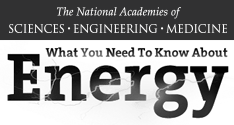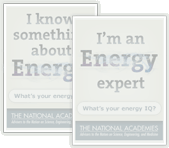
What You Need To Know About Energy
What do you know about energy?
In 2014, how much of the world's CO2 is released by the United States?
-
Sorry, that’s incorrect.
The United States emits about 18% of the world’s greenhouse gases, behind only China, which accounts for approximately one-quarter of total global emissions.
-
Correct!
The United States emits about 18% of the world’s greenhouse gases, behind only China, which accounts for approximately one-quarter of total global emissions.
-
Sorry, that’s incorrect.
The United States emits about 18% of the world’s greenhouse gases, behind only China, which accounts for approximately one-quarter of total global emissions.
-
Sorry, that’s incorrect.
The United States emits about 18% of the world’s greenhouse gases, behind only China, which accounts for approximately one-quarter of total global emissions.
Nuclear power provided what percentage of the total U.S. energy supply in 2013?
-
Sorry, that’s incorrect.
19% of our electricity was generated by nuclear fuel in 2013.
-
Correct!
19% of our electricity was generated by nuclear fuel in 2013.
-
Sorry, that’s incorrect.
19% of our electricity was generated by nuclear fuel in 2013.
-
Sorry, that’s incorrect.
19% of our electricity was generated by nuclear fuel in 2013.
A typical incandescent lamp (traditional light bulb) consumes 60 watts of power. How much do each of a compact fluorescent and LED lamp consume, in watts, to produce the same amount of light?
-
Sorry, that’s incorrect.
A typical incandescent lamp (traditional light bulb) that consumes 60 watts of power produces around 800 lumens. A compact fluorescent lamp emits the same amount of light while using only 13 watts. And an LED lamp consumes only 10 watts to give off the same 800 lumens.
-
Sorry, that’s incorrect.
A typical incandescent lamp (traditional light bulb) that consumes 60 watts of power produces around 800 lumens. A compact fluorescent lamp emits the same amount of light while using only 13 watts. And an LED lamp consumes only 10 watts to give off the same 800 lumens.
-
Sorry, that’s incorrect.
A typical incandescent lamp (traditional light bulb) that consumes 60 watts of power produces around 800 lumens. A compact fluorescent lamp emits the same amount of light while using only 13 watts. And an LED lamp consumes only 10 watts to give off the same 800 lumens.
-
Correct!
A typical incandescent lamp (traditional light bulb) that consumes 60 watts of power produces around 800 lumens. A compact fluorescent lamp emits the same amount of light while using only 13 watts. And an LED lamp consumes only 10 watts to give off the same 800 lumens.
The United States is home to how many of the world's automobiles?
-
Sorry, that’s incorrect.
With less than 5% of the world's population, the United States is home to one-third of the world's automobiles.
-
Correct!
With less than 5% of the world's population, the United States is home to one-third of the world's automobiles.
-
Sorry, that’s incorrect.
With less than 5% of the world's population, the United States is home to one-third of the world's automobiles.
What are ways that electricity system operators match power needs to generation on a day-to-day basis?
- Turning on or off adjustable, load-following generators
- Turning on or off short-term "peaker" plants
- Initiating demand-response actions, such as adjusting thermostats for customers who have agreed to it.
- Initiating energy storage, such as pumped hydro or battery storage.
- All of the above
-
Sorry, that’s incorrect.
Load-following and peaker plants, demand-response and energy storage are all ways that grid operators can adjust generation to meet demand.
-
Sorry, that’s incorrect.
Load-following and peaker plants, demand-response and energy storage are all ways that grid operators can adjust generation to meet demand.
-
Sorry, that’s incorrect.
Load-following and peaker plants, demand-response and energy storage are all ways that grid operators can adjust generation to meet demand.
-
Sorry, that’s incorrect.
Load-following and peaker plants, demand-response and energy storage are all ways that grid operators can adjust generation to meet demand.
-
Correct!
Load-following and peaker plants, demand-response and energy storage are all ways that grid operators can adjust generation to meet demand.
According to the Corporate Average Fuel Economy (CAFE) standards, what is the average miles per gallon (mpg) required for new cars, SUVs, and light trucks (combined) by 2025?
-
Sorry, that’s incorrect.
The most recent federal efficiency standards, finalized by the U.S. National Highway Traffic Safety Administration (NHTSA) and the Environmental Protection Agency (EPA) in 2012, are projected to increase fuel economy to the equivalent of 54.5 mpg for cars and light-duty trucks by model year 2025, while also reducing CO2 emissions.
-
Sorry, that’s incorrect.
The most recent federal efficiency standards, finalized by the U.S. National Highway Traffic Safety Administration (NHTSA) and the Environmental Protection Agency (EPA) in 2012, are projected to increase fuel economy to the equivalent of 54.5 mpg for cars and light-duty trucks by model year 2025, while also reducing CO2 emissions.
-
Sorry, that’s incorrect.
The most recent federal efficiency standards, finalized by the U.S. National Highway Traffic Safety Administration (NHTSA) and the Environmental Protection Agency (EPA) in 2012, are projected to increase fuel economy to the equivalent of 54.5 mpg for cars and light-duty trucks by model year 2025, while also reducing CO2 emissions.
-
Correct!
The most recent federal efficiency standards, finalized by the U.S. National Highway Traffic Safety Administration (NHTSA) and the Environmental Protection Agency (EPA) in 2012, are projected to increase fuel economy to the equivalent of 54.5 mpg for cars and light-duty trucks by model year 2025, while also reducing CO2 emissions.
-
Sorry, that’s incorrect.
The most recent federal efficiency standards, finalized by the U.S. National Highway Traffic Safety Administration (NHTSA) and the Environmental Protection Agency (EPA) in 2012, are projected to increase fuel economy to the equivalent of 54.5 mpg for cars and light-duty trucks by model year 2025, while also reducing CO2 emissions.
Which has been growing more, energy to heat homes or energy to cool homes?
-
Sorry, that’s incorrect.
Current trends indicate that by 2040 residential buildings will consume up to 28% less energy for heating but about 50% more for cooling.
-
Correct!
Current trends indicate that by 2040 residential buildings will consume up to 28% less energy for heating but about 50% more for cooling.
-
Sorry, that’s incorrect.
Current trends indicate that by 2040 residential buildings will consume up to 28% less energy for heating but about 50% more for cooling.
What is the commonly accepted unit of measurement for electric current—or the amount of an electric charge passing a point per unit time?
-
Sorry, that’s incorrect.
The ampere, or amp, is the most commonly used measurement for electric current.
-
Sorry, that’s incorrect.
The ampere, or amp, is the most commonly used measurement for electric current.
-
Correct!
The ampere, or amp, is the most commonly used measurement for electric current.
-
Sorry, that’s incorrect.
The ampere, or amp, is the most commonly used measurement for electric current.
How efficient are ordinary commercial solar cell units?
-
Sorry, that’s incorrect.
As of 2014, the very best experimental units could convert more than 40% of light energy to electricity; ordinary commercial units are in the range of 5% to 20%.
-
Sorry, that’s incorrect.
As of 2014, the very best experimental units could convert more than 40% of light energy to electricity; ordinary commercial units are in the range of 5% to 20%.
-
Correct!
As of 2014, the very best experimental units could convert more than 40% of light energy to electricity; ordinary commercial units are in the range of 5% to 20%.
-
Sorry, that’s incorrect.
As of 2014, the very best experimental units could convert more than 40% of light energy to electricity; ordinary commercial units are in the range of 5% to 20%.
Thank you for taking our quiz.
Place this badge on your facebook page to show your friends what you know about energy.
Place this badge on your facebook page to show your friends what you know about energy.
Place this badge on your facebook page to show your friends what you know about energy.
Explore Other Topics
Energy Hands-on
Understanding Efficiency
Learn the significance of energy efficiencyThe Promise of Better Lighting
Energy savings through lighting technologyOur Energy System
A visualization of all our energy sourcesEnergy Defined
- Global Warming
A term used to describe the phenomenon of Earth’s rising average near-surface temperature. Although such fluctuations have occurred in the past due to natural causes, the term is most often used today to refer to current warming trends. Most scientists have concluded that this is very likely due to the observed increase in human-generated greenhouse gas concentrations in the atmosphere.




